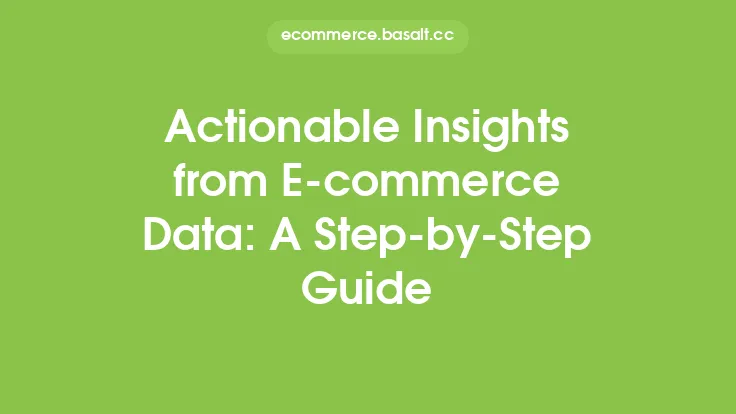In the world of e-commerce, data is king. With the vast amount of information available, it can be overwhelming to make sense of it all. This is where e-commerce dashboards come in – a centralized insights hub that helps online retailers and businesses make data-driven decisions. A well-designed dashboard provides a single source of truth, allowing users to monitor key performance indicators (KPIs), track customer behavior, and identify areas for improvement.
What is an E-commerce Dashboard?
An e-commerce dashboard is a visual representation of an online store's performance, typically displayed on a single screen or page. It is a customizable platform that aggregates data from various sources, such as website analytics, sales, customer interactions, and marketing campaigns. The dashboard provides real-time insights into the business, enabling users to respond quickly to changes in the market, customer behavior, or sales trends. By having all the essential metrics and KPIs in one place, e-commerce dashboards simplify the process of analyzing complex data, making it easier to identify opportunities and challenges.
Key Components of an E-commerce Dashboard
A comprehensive e-commerce dashboard should include a range of key components, such as:
- Sales and revenue metrics: total sales, revenue growth, average order value, and conversion rates
- Customer behavior: customer demographics, purchase history, browsing behavior, and loyalty program engagement
- Website performance: website traffic, bounce rates, page views, and load times
- Marketing metrics: email open rates, social media engagement, paid advertising ROI, and influencer partnership performance
- Inventory management: product stock levels, low-stock alerts, and supply chain performance
- Customer service: support ticket volume, response times, and customer satisfaction ratings
Benefits of Using an E-commerce Dashboard
The benefits of using an e-commerce dashboard are numerous. Some of the most significant advantages include:
- Improved decision-making: with all the essential data in one place, users can make informed decisions quickly and confidently
- Enhanced productivity: automated data collection and visualization save time and reduce the need for manual data analysis
- Increased transparency: dashboards provide a clear and concise view of business performance, making it easier to identify areas for improvement
- Better customer insights: by tracking customer behavior and preferences, businesses can create more targeted marketing campaigns and improve customer satisfaction
- Real-time monitoring: dashboards enable users to respond quickly to changes in the market or customer behavior, reducing the risk of missed opportunities or unresolved issues
Best Practices for Creating an E-commerce Dashboard
To create an effective e-commerce dashboard, follow these best practices:
- Define clear goals and objectives: determine what you want to achieve with your dashboard and what metrics are most important to your business
- Choose the right data sources: select the most relevant data sources and ensure they are accurate and up-to-date
- Keep it simple and intuitive: use clear and concise language, and avoid cluttering the dashboard with too much information
- Use data visualization: leverage charts, graphs, and other visualizations to make complex data easy to understand
- Make it customizable: allow users to personalize the dashboard to suit their needs and preferences
- Ensure mobile accessibility: make sure the dashboard is accessible and usable on mobile devices, enabling users to monitor their business on-the-go
Common E-commerce Dashboard Tools and Platforms
There are many tools and platforms available for creating e-commerce dashboards, including:
- Google Data Studio: a free platform for creating custom, web-based dashboards
- Tableau: a data visualization platform that connects to a range of data sources
- Microsoft Power BI: a business analytics service that provides interactive visualizations and business intelligence capabilities
- Salesforce: a customer relationship management (CRM) platform that includes dashboard and reporting tools
- Shopify: an e-commerce platform that provides built-in dashboard and analytics tools
- Custom solutions: many businesses opt for custom-built dashboards using programming languages like Python, JavaScript, or R
Overcoming Common Challenges
When creating an e-commerce dashboard, businesses may encounter several challenges, such as:
- Data quality issues: ensuring the accuracy and completeness of data is crucial for making informed decisions
- Integration with multiple data sources: connecting to various data sources can be complex and time-consuming
- Information overload: avoiding clutter and ensuring the dashboard is easy to use and understand is essential
- Limited resources: small businesses or those with limited budgets may struggle to create and maintain a comprehensive dashboard
- Security and access control: ensuring the dashboard is secure and access is restricted to authorized personnel is vital
Future of E-commerce Dashboards
The future of e-commerce dashboards is exciting, with emerging trends and technologies set to revolutionize the way businesses interact with data. Some of the key developments to watch include:
- Artificial intelligence (AI) and machine learning (ML): integrating AI and ML into dashboards will enable businesses to uncover hidden insights and predict future trends
- Internet of Things (IoT) integration: connecting dashboards to IoT devices will provide real-time insights into customer behavior and preferences
- Augmented reality (AR) and virtual reality (VR): using AR and VR to visualize data will create immersive and interactive experiences
- Cloud-based solutions: cloud-based dashboards will provide greater scalability, flexibility, and accessibility
- Mobile-first design: designing dashboards with mobile devices in mind will ensure businesses can monitor their performance on-the-go.




